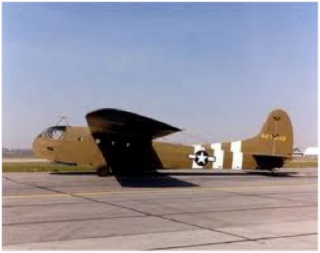Who Are The Aviators Who Wear The Silver Wings With The Letter “G” – March 3, 2017

Alberto Santos-Dumont – February 24, 2017
February 24, 2017
The Day The Japanese Bombed Oregon – March 10, 2017
March 10, 2017Robert Novells’ Third Dimension
March 3, 2017
Good Morning,
A few weeks ago we talked about aviation during WWII and the numbers for aviation related products provided, total number of aircraft produced, and aircrews lost. This week I want to acquaint you with the unsung heroes who wore the silver wings with the letter “G”…………the glider pilots.
Enjoy…..
General Westmoreland’s Comments
On The Glider Pilots Of WWII
“The intrepid pilots who flew the gliders were as unique as their motorless flying machines. Never before in history had any nation produced aviators whose duty it was deliberately to crash land and then go on to fight as combat infantrymen. They were no ordinary fighters. Their battlefields were behind enemy lines.”
“Every landing was a genuine do-or-die situation for the glider pilots. It was their awesome responsibility to repeatedly risk their lives by landing heavily laden aircraft containing combat soldiers and equipment in unfamiliar fields deep within enemy-held territory, often in total darkness. They were the only aviators during World War II who had no motors, no parachutes, and no second chances.–General William C. Westmoreland, U.S. Army, Retired
National WWII Glider Pilots
Association, Inc
American glider pilots, along with airborne forces, spearheaded all the major invasions, landing behind enemy lines in their unarmed gliders in Sicily, Normandy, Southern France, Holland, Bastogne, Rhine Crossing, Luzon in the Philippines, and Burma.
One veteran American glider pilot painted a vivid picture of the stark terror they experienced. “Imagine”, he said, “flying a motorless, fabric-covered CG-4A glider, violently bouncing and jerking on a 11/16 inch thick nylon rope 350 feet back of the C-47 tow plane. You see the nervous glider infantrymen behind you, some vomiting, many in prayer, as you hedge-hop along at tree-top level instinctively jumping up in your seat every time you hear bullets and flak tearing through the glider. You try not to think about the explosives aboard. It’s like flying a stick of dynamite through the gates of Hell.”
There were only about 6,000 American military glider pilots, all volunteers. They proudly wore the silver wings with the letter “G” superimposed on them. The brash, high-spirited pilots were not a bit bashful about letting everyone know that the “G” stood for “Guts”.
American glider pilots were scheduled for “Operation Eclipse”, the Allied airborne offensive planned to capture Berlin. But, the glory went, through political default, to Russian ground forces. They were spared an invasion of Japan when the atomic bombs fell on Hiroshima.
They suffered heavy casualties and their ranks have thinned through the years until now only about 390 are banded together in The National World War II Gliders Pilots Association with its headquarters at 4037 Ringdove Way, Roanoke, TX 76262,. They are a vanishing breed. There will be no future generations of American military glider pilots. The Defense Department ended the military glider pilot program in 1952.
World War II Glider Pilots; none had ever been before and probably none will ever be again; a hybrid breed like jackasses with no need to reproduce themselves; definitely one of a kind understood only by themselves and some completely beyond understanding. A few more years and military glider pilots will be an extinct species remembered by few. But they did exist and were involved in some mighty important and exciting military actions in WWII.
I cannot begin to imagine the pressure the crews, and passengers, were under when they released from the tow plane. Aviation is full of challenges but I don’t think you could face a greater challenge than the crews who wore the Silver Wings with the letter “G.”
Now what about the airplane itself? There were around 14,000 of the CG4A Gliders produced by a number of different companies in the US and the specifications were as follows:
Wing Span— 83 feet, 8 inches
Length (Overall)—48 feet, 3-3/4 inches
Height—12 feet, 7-7/16 inches
Weight, design— 3,750 pounds
Gross Weight, design—7,500 pounds
Wing Chord—10 feet, 6 inches
The Americans were not the only ones to employ this asset. The Germans led the way followed by the Russians, USA, and Britain. The British manufactured a glider called the Airspeed Horsa. This was manufactured in Britain by Airspeed LTD, and was named the Horsa after a 5th century German mercenary.
The specifications for the Horsa are as follows:
Capacity—25 passengers
Length—67 ft (20.4 m)
Wingspan—88 ft (26.8 m)
Height—21 ft (6.4 m)
Wing area—1,148 ft² (106.7 m²)
Empty—7,500 lb (3,400 kg)
Loaded—15,250 lb (6,920 kg)
Towing speed—127 mph (204 km/h)
Gliding speed—100 mph (160 km/h)
There is a lot of information out there on the Gliders used in WWII and I encourage you to take some time to look around and reacquaint yourself with the facts. I have a video that has some very valuable footage on the Glider program but it will take you an hour to view it all; however, it is well worth your time.
Have a good weekend, enjoy your time with friends and family, and please remember that we all need to focus on time management—life is short.
Robert Novell
March 3, 2017
P.S.-Although most of the gliders used at Normandy were lost many were recovered and the recovery method was a real adventure for all concerned.
Glider Pulled Into the Air from a Standing Start
A glider snatch was accomplished by a C-47 tow plane flying just above ground level with a hook trailing behind from a cable that played out from a revolving drum in its fuselage. The hook snagged a glider towrope suspended between two vertical poles sweeping it airborne behind the tow plane from a dead standstill to 120 mph in a matter of 7 seconds.





